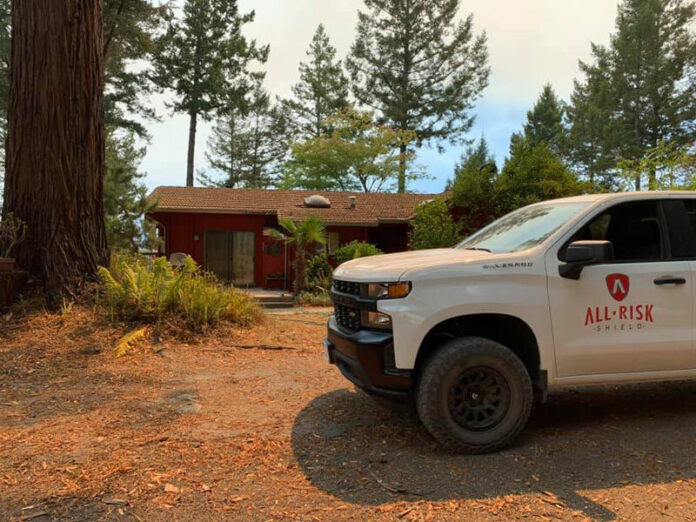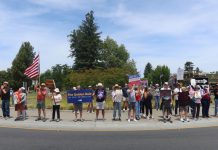While fire crews, dozers, hand crews and strike teams worked on building lines to contain the Walbridge Fire to prevent it from coming down to Korbel, Hacienda and other river communities, Bobby Payne was checking on homes in the lower Russian River area and safeguarding properties and hard to reach areas with retardant.
Instead of a soft launch like Payne had planned for the northern California branch of his business partner’s fire protection service, All Risk Shield, Payne found himself getting straight to work helping to protect homes and hillsides in response to the Walbridge Fire.
Payne, who is an operational firefighter and an active duty firefighter/medic with the United States Air Force, co-owns the company with his friend Joe Torres, a fire captain with the Santa Monica Fire Department.
“I co-own a company with my buddy Joe, he runs the southern California division, and that’s where the company started. It’s called All Risk Shield and we do preventive measures to protect people’s homes. So, we would come out to your house in the off-season and tell you what you need to do and help you with those procedures and put an application of Phos-Chek (retardant) down, which is the same stuff they drop from the aircraft, ours is just not red. In an event like we had over the last couple of weeks we would check on your property,” Payne said.
Payne started the northern division of the company around six weeks ago with the intention of working on marketing and playing the field, but then during the last two weeks “everything went from zero to 100.”
As an operational firefighter with 20 years of experience, Payne has the certifications to get in behind roadblocks and into fire zones. Once the Walbridge Fire started, he got to work immediately defending areas in the Cazadero, Sweetwater Springs and Cherry Road areas.
“With this unique niche of a company that I just brought up to Northern California about a month and a half ago, I saw a unique opportunity to get into very tight spots that I know first-hand a lot of fire trucks would not be able to gain access to … and I figured if I can get into these little pockets and if I can protect, not necessarily individual homes but if I can protect this hillside, it will help everybody on his street or on this side of the canyon and I just went to work to try and help the town,” Payne said.
As he started posting videos of his efforts on various social media pages his phone started getting a constant stream of texts and calls from anxious residents asking Payne to check on their home.
He even started feeding animals, taking photos of people’s homes and saving precious family items for residents.
“And it just kind of blew up into all of these different projects and just doing whatever I could and going back every day,” Payne said. “For me this was strictly work in my second gig with my All Risk Shield truck with a giant tank and pump system in the back and a bunch of Phos-Chek and logistically trying to figure out how to continue to have this Phos-Chek agent so I wouldn’t run out and continue provide as much protection as I could in those very hard to reach areas that I knew could be very pivotal if the fire was to climb over the hill.”
On the second day of the fire, Payne was able to save a property on Sweetwater Springs Road where the fire was approaching the home from a nearby hillside.
“When I was protecting this property the homeowners were evacuating when I was coming up the hill and they said, ‘We don’t feel we have a fighting chance at all, if there is anything you can do, just do it.’ So, I protected the property and I could see the fire right on the hill,” Payne recalled.
He knew he had some distance and wasn’t worried about safety concerns at that point so he sprayed the property with the retardant, which is people and pet safe and environmentally friendly. It’s also not stained red like the material that is dropped by Very Large Air Tankers (VLAT’s) and other aircraft (Payne said the only reason the retardant that fire crews use is stained red is because crews need to be able to see where they are dropping the material).
After Payne sprayed the home on Sweetwater Springs Road he returned the next day to check on things.
“The next day I was driving back on Sweetwater and I saw the fire had jumped the highway and they (the resident’s homes) were on the south side of the highway and I went up there to check on things,” Payne said. “I honestly believe things happen for a reason. If I had been there 15 minutes later their house would have been completely on fire. The fire was climbing the hill and where I sprayed my line of Phos-Chek it had the fire stopped, but then the fire was trying to navigate around and climb trees and so it slowed it down and stopped it in some portions, exactly like it’s supposed to. The fire was trying to find a new path and I was able to fire up my truck and extinguish the fire.”
Payne stayed at the home for about four hours, fighting multiple fires on the property, chopping down trees and securing lines. He said it was difficult work because the property’s water system had melted and he had to go down to a different house to fill up on water multiple times.
“I kept going up and going up and just fighting fire and chopping trees down and doing whatever I could,” Payne said.
The only structure lost on that property was a green house, but everything else was saved.
He said once he saved that particular home he kept getting calls and requests to check on other homes in the area and after about a day of trying to respond to texts and check on countless homes he told folks that he was going to focus on the entire community and neighborhoods, a strategy that proved to be effective.
“I said ‘I am 100% focused on taking care of the entire community and neighborhoods’ and if I could do things the way I need to do them it could save all of the homes of all of the people asking for individual services,” Payne said.
When asked of Payne what he thought was a turning point for the Walbridge Fire for the lower Russian River area, he said a pivotal moment was when crews were able to construct a hefty dozer line from Mount Jackson down to Korbel.
“I think the biggest turning point was when they were able to doze a line from Mount Jackson all the way to Korbel. The terrain is so tricky up there and it is hard to access… but I think that was a pivotal moment and then all of a sudden the heavens opened up and the weather got phenomenal,” Payne said.
He said the days that crews were able to get aid from VLATs, 747s, the DC -10s and the National Guard also marked a turning point.
“Those extra aircraft really tipped the scales as well,” he said.
Payne, whose grandfather was a firefighter with the Seattle Fire Department, said he always wanted to be a firefighter after frequently spending time in the fire house as a kid.
“My grandfather was a Seattle fireman and my goal after high school was to become a Seattle fireman. My grandpa said, ‘As an 18-year-old kid you’re not going to get in the Seattle Fire Department…’ So, I joined the Air Force as a firefighter/medic and got some certifications,” Payne said.
He is currently on active duty and works with the Travis Air Force Base and the Two Rock Coast Guard in Petaluma.
“For me it’s just wanting to help people and we’ve been hit so hard as a community up here, I saw an opportunity to just do what I can to take care of people. It wasn’t business-centric motivated it wasn’t any of that, it was just that I had the ability to get in there and do whatever I could to help people.”
He said even though the fire is getting close to containment there will still be a lot of mop up work to do behind the scenes in the fire zone.
“We will continue to work on that fire in some capacity. It is safe for everyone to be home, 100%, but there will be crews continuing to work around the clock on that fire because come next month when the winds start to pick up that fire could easily kick off so a lot of work goes on in the back end and that goes unnoticed sometimes,” Payne said.
He said if the fire occurred during the windy season of October or early November then it could have been really “catastrophic.”
“Now, with true fire season coming up, you have a lot of charred space and a lot of incredible dozer lines,” he said.









